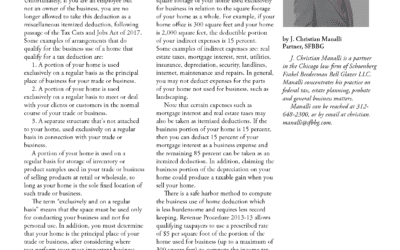The ownership of life insurance is a much-needed component of business succession and personal financial plans. Life insurance needs vary from funding needed to purchase the ownership interest of a business partner upon death, creating liquidity for the family of a decedent for the payment of estate taxes or providing cash for surviving family members. In many cases, the purchase of permanent insurance is needed rather than term insurance where the coverage will lapse after some period of time. Despite the need for insurance coverage, many prospective purchasers elect not to purchase much-needed whole life insurance coverage and either opt to purchase less expensive term insurance or refrain from purchasing insurance altogether.
Prospective insurance purchasers should consider some of the available means of premium financing to procure the necessary coverage. Financing premiums for life insurance purposes has become an increasingly popular technique, particularly in a low interest rate environment. One means of premium financing is to utilize a third-party lender to finance premiums. This allows a prospective insured to purchase a policy with borrowed funds, thereby leaving portfolio assets intact for future growth and income. By not liquidating portfolio investments, insurance can be purchased without incurring the income tax cost that will arise on the sale of appreciated portfolio assets. Although interest rates have increased in recent months, rates are still relatively low from an historical perspective and will not prevent premium financing from serving as an effective insurance purchasing tool.
In a premium financing arrangement, an insured creates a trust to become the owner of a life insurance policy on his or her life. The trust arrangement is necessary so that the policy proceeds will not be subject to estate taxes at the insured’s death. The policy must be a whole life insurance policy or some other type of policy that has a cash value component; a term life insurance policy that has no cash buildup within the policy will not provide sufficient collateral for, nor a means of repaying, the loan to the lender. A bank or other institution will loan funds to the trust for the payment of policy premiums. The trust in turn pledges the policy to the bank to secure the premium advances although other collateral may be utilized as the lender may permit. The trust must pay the interest charges on an annual or more frequent basis to the bank, but the interest payments on the outstanding loan will be far less than the premium payments themselves. After a sufficient number of years have lapsed and there is a meaningful amount of cash value accumulated in the policy, the trust can borrow or otherwise withdraw cash from the policy and use the funds received to repay the lender. The policy will continue in force and the policy proceeds will be payable upon the insured’s death. The insured will essentially have financed insurance payments and only paid interest charges to maintain the policy without liquidating investment assets for premium payments.
A classic third-party premium financing arrangement is generally available only to individuals who are purchasing significant amounts of insurance on their lives. A variation of this technique, however, may be more desirable for those individuals who are not purchasing insurance in an amount large enough to attract the interest of a third-party lender. A prospective insurance purchaser with a portfolio of securities can take a margin loan from the insured’s investment portfolio and self-finance the premiums by transferring the borrowed funds to the trust holding the insurance policy which are needed for premium payments. In this case, the trust need not and should not pledge the policy to the insured/lender to secure the repayment to avoid having the insurance proceeds taxed to the insured’s estate at death. The end result is the same as with a third-party lender; the insured has procured insurance coverage without liquidating portfolio assets and incurring income taxes on the sale of appreciated securities in the insured’s portfolio.
One of the concerns with any self-financed premium arrangement is the large amount of transfers which must be made to the insurance trust each year for premium payments. Annual transfers or gifts made to the trust to enable the trust to pay premiums are gifts which utilize some portion of the insured’s estate and gift tax exemption, which shelters the amount of the insured’s assets which are subject to transfer taxes. As an alternative to gifting premiums to the insurance trust, the insured can loan money to the trust which the trust can utilize to pay the policy premiums. The loan must bear interest at a market rate and interest should be paid to the insured each year. If the insurance trust does not pay the annual interest charge, the foregone interest payments will constitute gifts which may utilize a portion of the insured’s transfer tax exemption. Even in that case, however, the reportable income from the insured’s forgiveness of the interest payment will be far less than the gift of the premiums. One advantage of private premium financing is that the loan need only bear interest at the IRS rate of interest which is substantially less than the market rate of interest a conventional lender will charge.
Regardless of which variation of premium financing arrangement is used, there are risks to the arrangement. A rise in interest rates can make it more expensive to finance the premium payments. Similarly, a meaningful decrease in the value of portfolio assets may require more capital to be contributed to the portfolio to sustain an existing margin loan. Problems may also arise if the policy does not perform as expected and the loan cannot be repaid as originally scheduled.
One way to view premium financing is to compare the alternative of paying insurance premiums out of pocket with the purchase of insurance with borrowed funds. An insured who pays the insurance premiums is out of pocket for the full amount paid each year. On the other hand, an insured who borrows the funds is only out of pocket for the interest cost each year. Considering that the loan is not repaid with the insured’s own funds but from the policy cash build up, most individuals having long-term insurance needs will opt for financing the insurance with borrowed funds.
Various circumstances call for the purchase of whole life insurance. A properly structured financing arrangement can provide an inexpensive means of paying insurance premiums that does not require the liquidation or use of other personal assets.
Please contact Bruce Bell with any questions at (312) 648-2300 or e-mail at [email protected].



